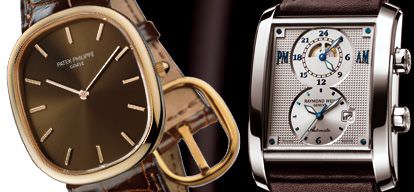The Japanese move up-market
From Hermès, we rushed over to a large conference hall, which was filled to overflowing. Seiko was announcing the official launch of its Spring Drive. This mechanism is a new type, in which a ‘tri-synchro regulator’ replaces the traditional balance/escapement duo. The major benefits are the 72-hour power reserve, a 30% faster winding rate, increased precision to +/- 1 second per day, and a continuous slide of the hands without any jump. This new product also announces a move up-market by the large Japanese company, which is determined to compete with the Swiss bastions of ‘haute horlogerie’. Thus, the models presented were all assembled by five carefully chosen watchmakers, and the design was particularly well thought out. With a retail price of around 3,400 ¤ and a global distribution network deliberately limited to 300 sales points, Seiko hopes to make definite inroads into the circles of collectors and other aficionados. (For more details on the Spring Drive, see Europa Star 2.05.)
After this announcement, it was the turn of another large Japanese group, Citizen. This brand is placing its bets on the Eco-Drive hybrid movements that already represent 55% of its sales. Its largest market is the United States, with a wide assortment of multi-functional models. For Citizen, the future depends on the fusion between its Eco-Drive movements, which do not require a battery and are thus environmentally friendly, and ‘radio-control’ technology, which is one of the brand’s specialties. This year will also see the introduction of the world’s smallest radio-controlled watch, in a new ladies’ collection. Stylistically, the Japanese enterprise is making huge strides, notably in the Stileto collection, with its very delicate tonneau models equipped with lunar phases and even perpetual calendars. Its sports series have also been redesigned, especially the Aqualand, with totally integrated pushbuttons and hi-tech functions such as a loud alarm.
Moving up-market, and confirmed images
At Raymond Weil, a crowd pushed in to see the latest facelifts of the various collections. Olivier Bernheim, the CEO of the family brand, discussed the gradual move up-market. “For three years, the brand has been rethinking its production, reducing its assortment, and increasing the average sales price, as well as selecting its sales points in the 86 countries where it is present,” he explains from a small podium.
The Don Giovanni Cosi Grande Two Time Zones is the most emblematic of the brand’s entrée into the universe of watch complications. The dial is clearly divided into two indicators, with alternating Arabic numerals representing the 24 hours for one, and hour markers over the 12 hours for the other. The watch is equipped with only one mechanical movement that includes a gearing system that controls the two time displays. The execution is irreproachable, with pearled bridges and the Côtes de Genève pattern. Raymond Weil expects to strongly mark his entry into this new sector. Other emblematic models, such as the brand’s jewellery line, bear witness to this determination.
Finally it was time to visit Patek Philippe’s stand, where we were received by a small group in one of the several rooms making up the most impressive stand at BaselWorld. Europa Star has already spoken at great length about the remarkable technical achievements, the new silicon anchor wheel, realized by the flagship brand of Geneva’s haute horlogerie. (see Europa Star 2.05.)
Patek Philippe certainly has not stopped with this innovation, however. At BaselWorld, the brand unveiled a whole series of adaptations so that, as it says, “it can change while remaining the same.” A few of Patek Philippe’s most ‘emblematic’ models have been revisited. Besides the Annual Calendar that we already presented in our previous issue, Patek Philippe has revisited its Calatrava Ref. 600, giving it a slight sporty touch with the addition of a date hand, black dial with Arabic numerals, white ‘stick’ hands, and a domed sapphire crystal. The same graphical inspiration of the 1930s is found in the Calatrava Ref. 5296, with its silvered dual time zone dial, and its leaf hands in blued steel, all offering perfect readability.
The Ellipse d'Or, a novel model when it appeared in 1968, rapidly became one of the icons of the brand. It is now giving way to what the brand’s managers call a “return to dandyism” with the subtle alliances of pink gold and a chocolate brown dial, or white gold with an anthracite dial, or even yellow gold with a blue gold dial, set off with a brilliant navy blue bracelet. A must for refined gourmets.
The Nautilus collection has seen the appearance of its first model with complications – which still remains at a more than reasonable total thickness of 3.98 mm. These complications, as the brand reminds us, are “useful complications” such as a power reserve indicator, date hand, and lunar phase display. We should note in passing that this watch is exceptionally precise: in 122 years and 45 days, it will have deviated only 1 day in relation to the true lunar cycle!

Patek Philippe, Raymond Weil
Last but not least, Patek Philippe presents, this year, an original movement: its first wristwatch chronograph entirely designed, developed and fabricated in-house by the manufacture. It seems, too, that this new flyback chronograph is also the thinnest ever realized.
TO BE CONTINUED...
In the forthcoming days, the rest of this lenghty survey will be added to our europastar website.
BASELWORLD & SIHH: Part 1
BASELWORLD & SIHH: Part 2
BASELWORLD & SIHH: Part 3
BASELWORLD & SIHH: Part 4
BASELWORLD & SIHH: Part 5
BASELWORLD & SIHH: Part 6
Source: April -May 2005 Issue
Click here to subscribe to Europa Star Magazine.








